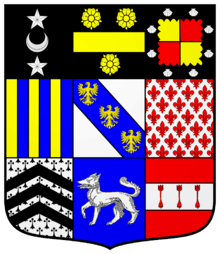Thomas Jermyn (died 1645)
Sir Thomas Jermyn (1573–1645) was an English politician, courtier and Royalist who sat in the House of Commons variously between 1604 and 1640.

Early life
Jermyn was the son of Sir Robert Jermyn of Rushbrooke, Suffolk. He was admitted at Emmanuel College, Cambridge in 1585. He was knighted at Rouen, France in 1591 and became Knight of the Bath in 1603.[1]
Career
In 1604, Jermyn was elected Member of Parliament for Andover and held the seat until 1611. In 1614, he was elected MP for Suffolk. He was elected for Bury St Edmunds in the elections in 1621, 1623, 1625, 1626 and 1628. In 1629 King Charles decided to rule for eleven years without parliament. [2]
In April 1640, Jermyn was re-elected MP for Bury St Edmunds in the Short Parliament.[3] He became Lord Lieutenant of Suffolk in 1640, and also served as Comptroller of the Household between 1639 and 1641.[1] He fought as a Royalist during the English Civil War and became disabled through injury in 1644. He died a year later at the age of 72.
Marriage and children
.jpg)
Jermyn married Catherine Killigrew (born 1579) a daughter of Sir William Killigrew (died 1622)[1] of Hanworth, Middlesex, a courtier to Queen Elizabeth I and to King James I, whom he served as Groom of the Privy Chamber. Her portrait by Marcus Gheeraerts the Younger (1561–1636) survives in the collection of the Yale Center for British Art, Connecticut, USA. By his wife he had children including their eldest surviving son, Thomas Jermyn (died 1659), also MP for Bury St Edmunds; and Henry Jermyn, 1st Earl of St Albans.
Notes
- 1, Sable, a crescent between two mullets in pale argent (Jermyn); 2, Sable a fess between three roses or (Rushbrook);. 3, Quarterly or and gules, on a bordure engrailed sable eight escallops argent (Heveningham); 4, Paly of six or and azure (Jarvill); 5, Argent, on a bend azure three eagles displayed or (Gissinge); 6,Argent, semy of fleurs-de-lys gules (Redesham); 7, Ermine, three chevrons sable (Reppes); 8, Azure, a hound passant argent (Burgon) (as for Burgoyne of South Tawton, Devon); 9, Gules, three bird-bolts in fess argent (Bozum) (here depicted erroneously as on a fess argent three bird-bolts gules)
References
- "Jermyn, Thomas (JRMN585T)". A Cambridge Alumni Database. University of Cambridge.
- "JERMYN (GERMAINE), Sir Thomas (1573-1645), of Rushbrooke, nr. Bury St. Edmunds, Suff. and Whitehall". History of Parliament Trust. Retrieved 20 March 2019.
- Willis, Browne (1750). Notitia Parliamentaria, Part II: A Series or Lists of the Representatives in the several Parliaments held from the Reformation 1541, to the Restoration 1660 ... London. pp. 229–239.
External links
- MacCulloch, Diarmaid. "Jermyn, Sir Thomas". Oxford Dictionary of National Biography (online ed.). Oxford University Press. doi:10.1093/ref:odnb/37601. (Subscription or UK public library membership required.)
| Parliament of England | ||
|---|---|---|
| Preceded by Henry Ludlow Nicholas Hyde |
Member of Parliament for Andover 1604–1611 With: Thomas Antrobus |
Succeeded by Richard Venables Peter Noyes |
| Preceded by Sir John Heigham Robert Drury |
Member of Parliament for Suffolk 1614 With: Sir Robert Gardener |
Succeeded by Sir Robert Crane, 1st Baronet Thomas Clench |
| Preceded by Not enfranchised |
Member of Parliament for Bury St Edmunds 1621–1629 With: Josiah Woodford 1621 Anthony Crofts 1623 Sir William Spring 1625 Emanuel Gifford 1626 Sir William Hervey 1628–1629 |
Succeeded by Parliament suspended until 1640 |
| Preceded by Parliament suspended since 1629 |
Member of Parliament for Bury St Edmunds 1640 With: John Godbolt 1640 |
Succeeded by Thomas Jermyn Sir Thomas Barnardiston |